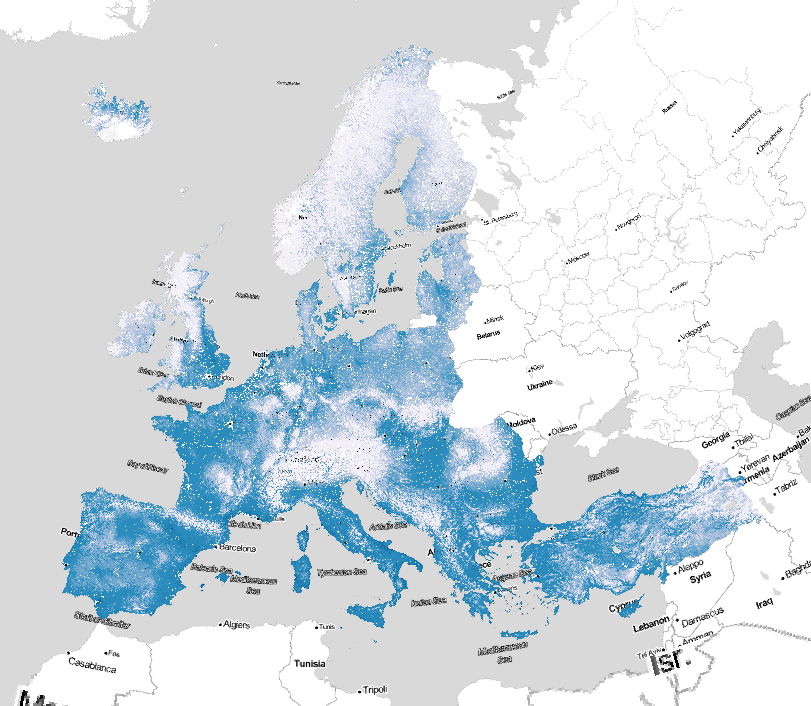You are viewing the Initial Version, the most recent version of this dataset.
1 version(s) available
Date of publication: August 9, 2023
Version 1
Date of publication: August 9, 2023
Type of change:
Description:

Predicted suitability for EUNIS habitat types (100m resolution) for EU27 countries
by Stephan HennekensThe modelled suitability for some of the EUNIS terrestrial habitat types is an indication of where conditions are favorable for each habitat type based on classified sample plot data European Vegetation Archive (EVA), predictors, and the Maxent software package (https://biodiversityinformatics.amnh.org/open_source/maxent/). The modelled suitability maps may be used as a proxy for the potential geographical distribution of the habitat types in giv ...(continue reading)
DOI 10.25829/zn5y29Citation
Hennekens, S., Mucher, S. (2023). Predicted suitability for EUNIS habitat types (100m resolution) for EU27 countries (Version 1) [Dataset]. German Centre for Integrative Biodiversity Research. https://doi.org/10.25829/zn5y29EUNISEuropeHabitats
| Entities |
|---|
| Arctic coastal saltmarsh |
| Atlantic saltmarsh driftline |
| Atlantic upper saltmarsh |
| Atlantic upper-mid saltmarsh and saline and brackish reed, rush and sedge bed |
| Atlantic mid-low saltmarsh |
| Baltic coastal meadow |
| Mediterranean upper saltmarsh |
| Mediterranean upper-mid saltmarsh and saline and brackish reed, rush and sedge bed |
| Mediterranean mid-low saltmarsh |
| Atlantic, Baltic and Arctic sand beach |
| Mediterranean and Black Sea sand beach |
| Atlantic and Baltic shifting coastal dune |
| Mediterranean, Macaronesian and Black Sea shifting coastal dune |
| Atlantic and Baltic coastal dune grassland (grey dune) |
| Mediterranean and Macaronesian coastal dune grassland (grey dune) |
| Black Sea coastal dune grassland (grey dune) |
| Atlantic and Baltic coastal Empetrum heath |
| Atlantic coastal Calluna and Ulex heath |
| Atlantic and Baltic coastal dune scrub |
| Mediterranean and Black Sea coastal dune scrub |
| Atlantic and Baltic broad-leaved coastal dune forest |
| Baltic coniferous coastal dune forest |
| Mediterranean coniferous coastal dune forest |
| Atlantic and Baltic moist and wet dune slack |
| Mediterranean and Black Sea moist and wet dune slack |
| Atlantic, Baltic and Arctic coastal shingle beach |
| Atlantic and Baltic rocky sea cliff and shore |
| Mediterranean and Black Sea rocky sea cliff and shore |
| Raised bog |
| Blanket bog |
| Oceanic valley mire |
| Poor fen |
| Relict mire of Mediterranean mountains |
| Intermediate fen and soft-water spring mire |
| Alkaline, calcareous, carbonate-rich small-sedge spring fen |
| Extremely rich moss-sedge fen |
| Tall-sedge base-rich fen |
| Calcareous quaking mire |
| Arctic-alpine rich fen |
| Tall-helophyte bed |
| Small-helophyte bed |
| Tall-sedge bed |
| Inland saline or brackish helophyte bed |
| Pannonian and Pontic sandy steppe |
| Cryptogam- and annual-dominated vegetation on siliceous rock outcrops |
| Cryptogam- and annual-dominated vegetation on calcareous and ultramafic rock outcrops |
| Perennial rocky grassland of the Italian Peninsula |
| Continental dry rocky steppic grassland and dwarf scrub on chalk outcrops |
| Perennial rocky grassland of Central and South-Eastern Europe |
| Heavy-metal dry grassland of the Balkans |
| Perennial rocky calcareous grassland of subatlantic-submediterranean Europe |
| Dry steppic submediterranean pasture of the Amphi-Adriatic region |
| Semi-dry perennial calcareous grassland (meadow steppe) |
| Continental dry grassland (true steppe) |
| Mediterranean closely grazed dry grassland |
| Mediterranean tall perennial dry grassland |
| Mediterranean annual-rich dry grassland |
| Iberian oromediterranean siliceous dry grassland |
| Iberian oromediterranean basiphilous dry grassland |
| Cyrno-Sardean oromediterranean siliceous dry grassland |
| Balkan and Anatolian oromediterranean dry grassland |
| Lowland to montane, dry to mesic grassland usually dominated by Nardus stricta |
| Open Iberian supramediterranean dry acid and neutral grassland |
| Oceanic to subcontinental inland sand grassland on dry acid and neutral soils |
| Inland sanddrift and dune with siliceous grassland |
| Mediterranean to Atlantic open, dry, acid and neutral grassland |
| Heavy-metal grassland in Western and Central Europe |
| Mesic permanent pasture of lowlands and mountains |
| Low and medium altitude hay meadow |
| Mountain hay meadow |
| Iberian summer pasture (vallicar) |
| Mediterranean tall humid inland grassland |
| Mediterranean short moist grassland of lowlands |
| Mediterranean short moist grassland of mountains |
| Submediterranean moist meadow |
| Moist or wet mesotrophic to eutrophic hay meadow |
| Moist or wet mesotrophic to eutrophic pasture |
| Temperate and boreal moist or wet oligotrophic grassland |
| Snow-bed vegetation |
| Boreal and arctic acidophilous alpine grassland |
| Temperate acidophilous alpine grassland |
| Arctic-alpine calcareous grassland |
| Alpine and subalpine calcareous grassland of the Balkans and Apennines |
| Thermophilous forest fringe of base-rich soils |
| Forest fringe of acidic nutrient-poor soils |
| Pteridium aquilinum vegetation |
| Lowland moist or wet tall-herb and fern fringe |
| Montane to subalpine moist or wet tall-herb and fern fringe |
| Herbaceous forest clearing vegetation |
| Mediterranean inland salt steppe |
| Continental inland salt steppe |
| Temperate inland salt marsh |
| Semi-desert salt pan |
| Shrub tundra |
| Moss and lichen tundra |
| Subarctic and alpine dwarf Salix scrub |
| Alpine and subalpine ericoid heath |
| Alpine and subalpine Juniperus scrub |
| Subalpine genistoid scrub of the Amphi-Adriatic region |
| Subalpine and subarctic deciduous scrub |
| Subalpine Pinus mugo scrub |
| Lowland to montane temperate and submediterranean Juniperus scrub |
| Temperate Rubus scrub |
| Lowland to montane temperate and submediterranean genistoid scrub |
| Balkan-Anatolian submontane genistoid scrub |
| Temperate and submediterranean thorn scrub |
| Low steppic scrub |
| Corylus avellana scrub |
| Temperate forest clearing scrub |
| Wet heath |
| Dry heath |
| Mediterranean maquis and arborescent matorral |
| Submediterranean pseudomaquis |
| Spartium junceum scrub |
| Thermomediterranean arid scrub |
| Western basiphilous garrigue |
| Western acidophilous garrigue |
| Eastern garrigue |
| Mediterranean gypsum scrub |
| Mediterranean halo-nitrophilous scrub |
| Western Mediterranean spiny heath |
| Eastern Mediterranean spiny heath (phrygana) |
| Western Mediterranean mountain hedgehog-heath |
| Central Mediterranean mountain hedgehog-heath |
| Eastern Mediterranean mountain hedgehog-heath |
| Temperate riparian scrub |
| Salix fen scrub |
| Mediterranean riparian scrub |
| Temperate Salix and Populus riparian forest |
| Alnus glutinosa-Alnus incana forest on riparian and mineral soils |
| Temperate hardwood riparian forest |
| Mediterranean and Macaronesian riparian forest |
| Broadleaved swamp forest on non-acid peat |
| Broadleaved mire forest on acid peat |
| Fagus forest on non-acid soils |
| Fagus forest on acid soils |
| Temperate and submediterranean thermophilous deciduous forest |
| Mediterranean thermophilous deciduous forest |
| Acidophilous Quercus forest |
| Temperate and boreal mountain Betula and Populus tremula forest on mineral soils |
| Southern European mountain Betula and Populus tremula forest on mineral soils |
| Carpinus and Quercus mesic deciduous forest |
| Ravine forest |
| Alnus cordata forest |
| Broadleaved deciduous plantation of non site-native trees |
| Mediterranean evergreen Quercus forest |
| Mainland laurophyllous forest |
| Olea europaea-Ceratonia siliqua forest |
| Phoenix theophrasti vegetation |
| Ilex aquifolium forest |
| Broadleaved evergreen plantation of non site-native trees |
| Temperate mountain Picea forest |
| Temperate mountain Abies forest |
| Mediterranean mountain Abies forest |
| Temperate subalpine Larix, Pinus cembra and Pinus uncinata forest |
| Temperate continental Pinus sylvestris forest |
| Temperate and submediterranean montane Pinus sylvestris-Pinus nigra forest |
| Mediterranean montane Pinus sylvestris-Pinus nigra forest |
| Mediterranean montane Cedrus forest |
| Mediterranean and Balkan subalpine Pinus heldreichii-Pinus peuce forest |
| Mediterranean lowland to submontane Pinus forest |
| Taxus baccata forest |
| Mediterranean Cupressaceae forest |
| Dark taiga |
| Pinus sylvestris light taiga |
| Pinus and Larix mire forest |
| Picea mire forest |
| Coniferous plantation of non site-native trees |
| Boreal and Arctic siliceous scree and block field |
| Temperate high-mountain siliceous scree |
| Temperate, lowland to montane siliceous scree |
| Mediterranean siliceous scree |
| Boreal and Arctic base-rich scree and block field |
| Temperate high-mountain base-rich scree and moraine |
| Temperate, lowland to montane base-rich scree |
| Western Mediterranean base-rich scree |
| Eastern Mediterranean base-rich scree |
| Temperate high-mountain siliceous inland cliff |
| Temperate, lowland to montane siliceous inland cliff |
| Mediterranean siliceous inland cliff |
| Temperate high-mountain base-rich inland cliff |
| Temperate, lowland to montane base-rich inland cliff |
| Mediterranean base-rich inland cliff |
| Temperate ultramafic inland cliff |
| Mediterranean ultramafic inland cliff |
| Wet inland cliff |
| Mediterranean, Macaronesian and temperate volcanic field |
| Intensive unmixed crops |
| Mixed crops of market gardens and horticulture |
| Arable land with unmixed crops grown by low-intensity agricultural methods |
| Inundated or inundatable cropland, including rice fields |
| Bare tilled, fallow or recently abandoned arable land |
| Mediterranean subnitrophilous annual grassland |
| Dry Mediterranean land with unpalatable non-vernal herbaceous vegetation |
| Trampled xeric grassland with annuals |
| Trampled mesophilous grassland with annuals |
| Annual anthropogenic herbaceous vegetation |
| Dry perennial anthropogenic herbaceous vegetation |
| Mesic perennial anthropogenic herbaceous vegetation |



